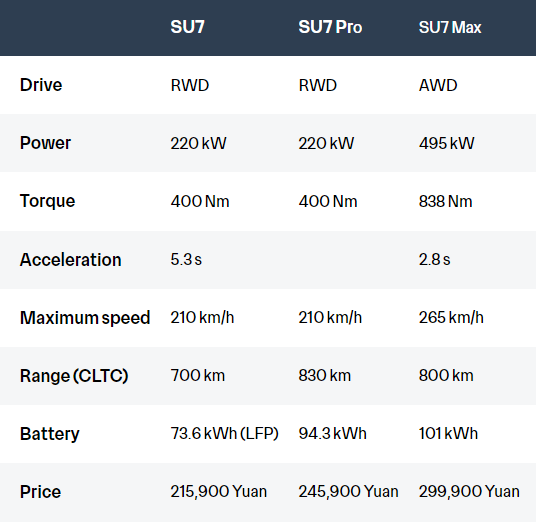Recently, the Beijing Auto Show was a flurry of activity as Xiaomi revealed the Xiaomi SU7, the much awaited electric car. Xiaomi is poised to upend the EV market with the release of the SU7, taking on industry heavyweights like Tesla and Porsche. This post explores all the important elements of the Xiaomi SU7, including its performance, features, design, and outlook.

Xiaomi SU7 at the Beijing Auto Show
At the Beijing Auto Show, the Xiaomi SU7 was the star of the show, attracting a lot of interest from both industry insiders and visitors. There was a noticeable excitement among the people waiting to see Xiaomi’s newest invention. The CEO of Xiaomi and self-made millionaire Lei Jun has made a successful foray into the automobile industry, creating waves with the introduction of the SU7.
Design: A Xiaomi Twist Pays Tribute to Porsche
The Porsche Taycan and the Xiaomi SU7 seem a lot alike at first sight, and this is not by accident. Lei Jun has a history of basing his business endeavours on popular forerunners, and the SU7 is no different. Porsche’s design aesthetic is evident in the car’s aerodynamic curves and sleek, five-meter-long chassis.
Also read :- Xiaomi’s SU7: Powering Up the Electric Revolution with Smart Speed and Innovation!
Still, the SU7 delivers more than simply style. It is more comfortable in the back seats and has more room for luggage than the Taycan. The car’s external design is sophisticated and practical, with a foldable spoiler and a softly curving rear apron.
Interior: Sophisticated Design Inspired by Tesla
The Xiaomi SU7’s internal design is influenced by Tesla’s elegant and understated aesthetic. A large, floating touchscreen serves as the dashboard’s focal point, while a smaller display below the steering wheel shows crucial driving information. Although it works, there aren’t many cutting-edge infotainment capabilities in this system. To improve the user experience, it effortlessly interacts with Xiaomi’s ecosystem, enabling connectivity with other Xiaomi devices.

The majority of the car’s features can be operated with voice commands, and there are a tonne of customisation choices available in the app store. Even with these capabilities, the entertainment system of the SU7 doesn’t reinvent the wheel; rather, it adheres closely to the high standards established by the leaders of the industry.
Performance: A Pleasure to Take Behind the Wheel
The driving dynamics of the Xiaomi SU7 are where it really excels. A thrilling driving experience is provided by the car’s precise steering, quick brakes, and sturdy frame. It differs from previous Chinese EVs in that it places a higher priority on comfort than performance.
Differences and Details in short
There are three different Xiaomi SU7 models: the SU7, SU7 Pro, and SU7 Max. These models differ in terms of performance and range. Here is a thorough examination of the details:

The entry-level SU7 Max has 495 kW of power and an 800 km range, while the base model has 220 kW of power and a maximum range of 700 km. The SU7 is favourably positioned against other high-end EVs thanks to these specs, but what really sets it apart is its price. With a starting price of just 215,900 RMB ($30,500), the SU7 is considerably more cost-effective than the Porsche and Tesla models, which will appeal to a lot of consumers.
Driverless Vehicles: The Future of EV cars
With the SU7’s hardware configuration, Xiaomi hopes to enable Level 4 autonomous driving in the future, allowing for hands-free driving. Though the car has certain limits when it comes to automated lane changes and lane guiding, these features are currently being developed. Although these characteristics are not these fully functional, Xiaomi’s commitment to over-the-air updates means that improvements are on the horizon.
Battery and Charging: Useful and Competitive
The Xiaomi SU7 is powered by three distinct packages of batteries that are built from reputable sources. With a BYD 74 kWh blade battery and a 400 volt system, or a 94 kWh CATL block and 800 volts, the rear-wheel drive car can go 668 to 830 km.
The CLTC standard states that the SU7 Max has an 800-kilometer range with a 101 kWh CATL battery. Xiaomi claims remarkable DC charging capabilities: 220 kilometres in five minutes, 390 kilometres in ten minutes, and 550 kilometres in fifteen minutes. However, AC charging at 11 kW may appear sluggish. These numbers put the SU7 in line with top performers in the market, such as the Porsche Taycan.

Conclusion
An important milestone in Xiaomi’s transition from a producer of smartphones to a major force in the electric car industry is the release of the SU7. Xiaomi is a strong competitor in the EV market thanks to its affordable price and feature-rich design, even though it may take influence from industry titans like Tesla and Porsche. The SU7 may emerge as a dominant player in the global market as production increases and autonomous driving technology develops, fulfilling Lei Jun’s audacious plans for Xiaomi’s future.
Disclaimer: The information presented in this article is based on available sources and may not be 100% accurate.
Source-1

